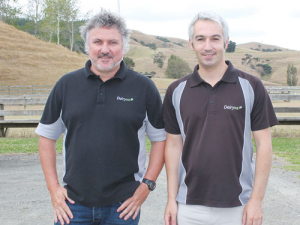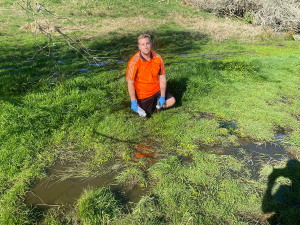A time-saving strategy is to shorten the milking time for up to 20% of the herd, says DairyNZ scientist Dr Paul Edwards.
Under the MaxT (maximum milking time) system 80% of the cows are milked out 100% as usual; with the slowest 20% of the herd the cups are taken off slightly early, “a little bit before the time we thought they may have finished milking,” Edwards explained at the DairyNZ Efficient Milking module at the Helensville Mini Milksmart.
Applying the MaxT milking strategy can increase the number of cows milked per hour in many dairies without changing the dairy, or affecting udder health or milk production and quality. Cows are milked to a pre-determined end point – either a fixed time point or set milk flow rate threshold (if using automatic cluster removers).
Edwards asked the Helensville audience if the concept sounded “scary”.
“For a long time in the industry there has been this belief that if you don’t milk every last drop of milk out of a cow you would cause mastitis, you would lose milk, etc,” he says. “This was to the point where we put weights on the clusters to try to milk every last drop of milk out of it.
“All the research suggests, at least for the modern cow, modern genetics, that we don’t need to milk every last drop of milk out. In fact we are more likely to be over-milking causing teat damage which then causes mastitis, rather than under-milking.
“We are not leaving litres of milk behind; we might run into problems if we do that. But we are talking about leaving an extra 200-300mls in the udder.”
If a cow is milking 20L plus at peak lactation, that amount of milk left behind is not a high proportion. Taking an extra two minutes to harvest that milk is not efficient.
Edwards says the udder has two compartments – the alveolar, where the milk is made – and each corner has a cistern. The latter is only where the milk can be harvested from.
When you put the cups on, the milk in the cistern drains out, then there is a brief dry period before milk let-down from the alveolar. In leaving a bit of milk behind in the cistern, milk ejection happens before it goes dry, so the cups are harvesting milk constantly.
“All we are doing is deferring one bit of milk from one milking to the next milking for it to be harvested more efficiently. It is a bit counter-intuitive that you can leave milk behind, save time and not lose production; it is almost too good to be true.”
Edwards says there are a few things to keep in mind. A high cell count – over 200,000 cells/ml – should be brought under control before applying MaxT.
However Australians have done research on applying MaxT to high cell count cows and didn’t find a problem. “Sometimes it is the over-milking that is causing the high cell count in the first place so applying MaxT can decrease you cell count.”
Genuinely elite cows doing 30% more than the herd average may take longer to milk out. However often they have high milk flow rates.
He could not definitely recommend MaxT for once-a-day cows as no research had been done. But after peak MaxT could be applied with caution.
“The guideline is to shorten the milking for 20% – maybe ease into it and do the first 5% to see how it goes for your individual situation.”
All milkers choose a different point at which to take the cups off, so some people are probably applying MaxT without even realising it.
In a herringbone, if you have 20 a side, 20% of 20 is four cows; when there are four cows left it is time to get going. With 40 a side it is the last eight cows.
In a rotary the rotation time can be adjusted (see DairyNZ website for calculation times). In some models automatic cup remover time settings can be adjusted; in others the low flow threshold should be adjusted from the default 0.2kg/min to 0.4kg/min.
An example of MaxT time saving: the slowest cow reduces time on the row from 11 min to 7.5 min; the operator time drops from 33 secs to 22s per cow; if you were milking 216 cows per hour you could now milk 318 cows; and you can save 53 minutes on a 2.44 hour milking time.
Edwards says New Zealand’s competitive advantage is low cost and we’ve always tried to make our farming labour efficient. All cows once were stripped before milking and machine stripped after. “Think of how much time that was costing.”
Stripping was progressively dropped as cows were bred that did not need it.
“Here today we don’t do either of those; now this is another evolution. Yes, there may be some cows that don’t suit the system. But if we breed for that, and end up culling them, we make the cows suit our system rather than working to the cow.”


















